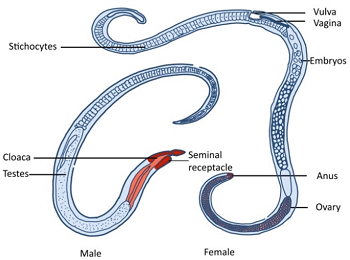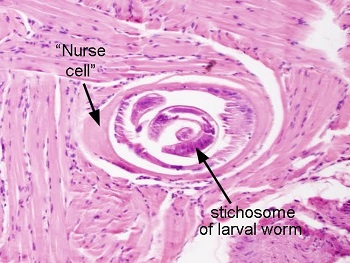Trichinella spiralis - Introduction, Classification, History, Habitat, Morphology
Introduction to Trichinella spiralis
Trichinella spiralis, commonly known as trichina worm or pork worm, is a parasite that occurs in pigs (primary host), rodents, bears, hyenas, and humans. This nematode causes a zoonotic infection in humans called trichinellosis.
The parasite is typically present in undercooked pork products and must not be confused with pork tapeworm- which is distantly related.
Classification of Trichinella spiralis
The classification of Trichinella spiralis is done as follows:
Kingdom: Animalia
Phylum: Nematoda
Class: Enoplea
Order: Trichocephalida
Family: Trichinellidae
Genus: Trichinella
Species: T. spiralis
History of Trichinella spiralis
Historically, in 1821, Tidemann in Germany first discovered the encysted larval stage of Trichinella spiralis in the muscles of an infected man.
Peacock and Own, in 1835, also discovered the parasite.
Habitat of Trichinella spiralis
Both the adult and larvae stages of the Trichinella spiralis parasite can be found in the same host. The adult form of the parasite inhabits the small intestine of men, rats, and pigs while the encysted larvae live in the striated muscles of these hosts.
Morphology of Trichinella spiralis
Trichinella spiralis is one of the smallest nematodes that can cause parasitic infection in man. Since a single host can harbor both the adult form and the larvae, the single host can act as the definitive host. Also, unlike other closely related parasites, there are no free-living stages of Trichinella spiralis.
Adult worm
adult Trichinella spiralis are very small and white, but visible to the naked eye
Male
male Trichinella spiralis measures about 1.5mm in length and 0.04mm in breadth
a short esophagus leads to a stichosome
absence of spicule and copulatory sheath
adult male worms have conspicuous conical papillae in the tail end which is an identifying feature
the male is short-lived as it dies immediately, within a week, after fertilization
as the male body degenerates, it is rarely seen in the feces

Image: adult Trichinella spiralis (Source: Springer Link)
Female
female Trichinella spiralis are larger than the males- about twice the length
measures 3 mm to 4 mm in length and 0.06 mm in breadth
presence of a single uterus which is filled with developing eggs in the posterior region and fully developed and hatched larvae in the anterior end
larviparous – produces only larvae but not eggs
larvae are passed out in the feces
during its lifetime of 16 weeks, one female can produce 1000 to 10,000 larvae

Image: Trichinella spiralis larvae in muscle cysts (Source: ResearhGate)
Larvae
measures 100 μm in length and 6 μm in breadth
remains coiled inside muscle cysts
highly infectious – cyst with a single larva can cause Trichinella spiralis infection
present only in the striated skeletal muscles but not in the cardiac or smooth muscles
inside the muscle cysts, the larvae develop and sexually matures
in 30 days, Trichinella spiralis larvae differentiates and reaches 10 times its original size – becomes 1 mm long
can remain viable for years before dying and getting calcified